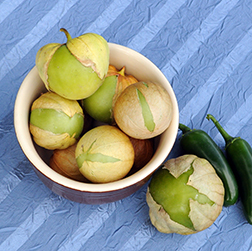Growing Tomatillo.
Best known as the primary ingredient in green salsa, it is a semi wild relative of the tomato. “The Mexican Husk Tomato” is more closely related to the gooseberry and has a tart, fruity flavor. Roasting enhances the taste, after which it may be blended with jalapeños, cilantro, onion, lime and garlic for salsa verde. Added to green chili, it gives the pork and green chili stew a little tang while thickening. Chicken enchiladas baked in a tomatillo cream sauce are a savory specialty dish.
The indeterminate tomatillo plant yield seemingly hundreds of paper lantern like fruit. As they mature, the husks round out, which may pop out when fully ripe. Look for husks without insect holes when picking tomatillos.
Locate tomatillo plants in a sunny area with moderately rich, well drained soil. Our heirloom tomatillo seeds can be directly sown in warm climates or started indoors 6 to 8 weeks before the last spring frost. Plant the tiny seeds 1/4″ deep in a good potting mix and keep evenly moist. Harden off before transplanting after all danger of frost has passed. Direct seed in warm climates, when soil temperatures reach 65º, 2′ to 4′ apart in rows 4′ to 5′ wide. Water occasionally, but don’t let them get too wet. The plants like to sprawl, so tomato cages are recommended. Harvest when husks are rounded out, but before the fruit inside turns yellow. The tart flavor is best when tomatillos are green but fill the husk. Grow two or more plants to insure pollination.
Good companion crops are basil, parsley, nasturtiums and marigolds. Bad companion crops are corn and kohlrabi.


